
Rhynchospora is a genus of about 400 species of sedges with a cosmopolitan distribution. The genus includes both annual and perennial species, mostly with erect 3-sided stems and 3-ranked leaves. The achenes bear a beak-like tubercule and are sometimes subtended by bristles. Many of the species are similar in vegetative appearance, and mature fruits are needed to make a positive identification.
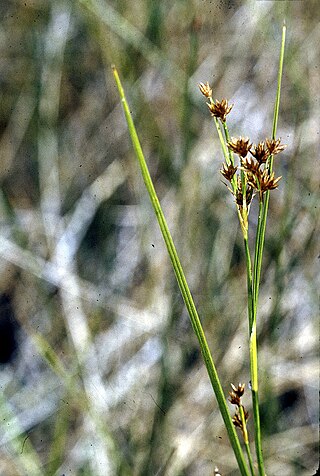
Rhynchospora capitellata is a species of sedge known by the common names brownish beaksedge and brownish beaked-rush. It is native to eastern North America and a few spots in the western United States. It grows in wet habitat, such as swamps, springtime meadows, and moist areas in forests. It is a perennial herb producing clumps of stems 20 to 100 centimeters tall, each stem sheathed with several narrow, pointed leaves. The inflorescence is a cluster of brown spikelets each about 3 or 4 millimeters long.

Lythrum alatum, commonly known as winged loosestrife, winged lythrum or angled purple-loosestrife, is a species of flowering plant belonging to the family Lythraceae. It is endemic to wetland areas in central and eastern United States and Ontario.

Rhynchospora knieskernii is a rare species of sedge known by the common name Knieskern's beaksedge. It is endemic to the state of New Jersey in the United States, where it occurs naturallyin the Pine Barrens. Reports have cited it present in Delaware as well, but these populations appear to have been introduced. It is threatened by the destruction and degradation of its habitat. It is a federally listed threatened species of the United States.
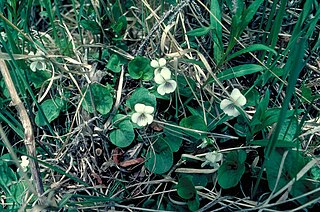
Viola renifolia is a species of violet known by the common names white violet and kidneyleaf violet. It is native to northern North America, where it has a widespread distribution across Canada and the northern United States as far south as Washington, Colorado, and New York.
Scirpus longii is a species of flowering plant in the sedge family known by the common name Long's bulrush. It is native to eastern North America, where it is limited to the Atlantic coastal plain.
Rhynchospora megaplumosa, the Manatee beaksedge, is a plant species endemic to a small region in central Florida. It is known from only 4 Counties: Polk, Hillsboro, Manatee and Sarasota. It generally grows on sandy soil in pine woodlands.

Sagittaria subulata, the awl-leaf arrowhead, narrow-leaved arrowhead or dwarf sagittaria, is an aquatic plant species that grows primarily in shallow brackish water along the seacoast, in marshes, estuaries, etc. It is native to the Colombia, Venezuela, and every US state along the coast from Massachusetts to Louisiana. It has also been reported as naturalized in Great Britain on just three occasions; only one of these is recent and it appears to have become extinct by 2010. It is also recorded as a non-native on the Azores, and on the Island of Java in Indonesia.
Bidens eatonii is a North American species of flowering plant in the family Asteraceae. It is native to eastern Canada and the northeastern United States.
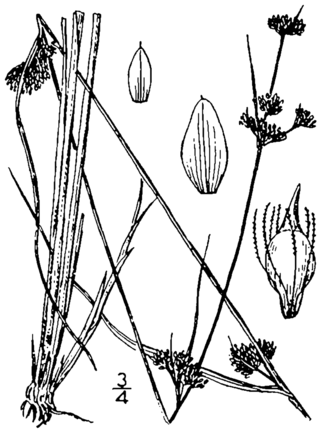
Rhynchospora capillacea is a species of sedge known by the common names needle beaksedge, slender beakrush and needle beakrush. It is native to eastern North America from Labrador to Alberta, and south to Texas. It grows in wet, usually calcareous habitat, such as fens, sandy or stony shores, interdunal flats, and wet meadows It is a perennial herb producing clumps of stems 10 to 40 centimeters tall, each stem with very narrow, filiform leaves. The inflorescence consists of few (1-4) narrow brown spikelets each about 6 or 7 millimeters long.
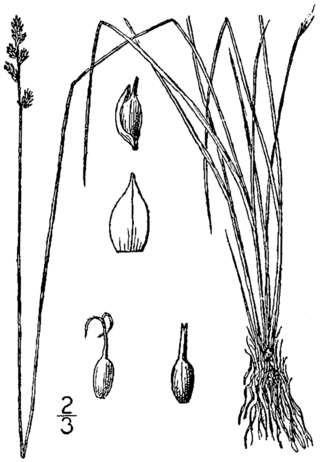
Carex sterilis, common names dioecious sedge, sterile sedge and Atlantic sedge, is a perennial plant native to North America.

Rhynchospora rariflora, commonly called fewflower beaksedge, is a species of flowering plant in the sedge family (Cyperaceae). It is native to North America, where it is found in the southeastern United States, Mexico, Belize, Honduras, Nicaragua, and the West Indies. Its typical natural habitat is sandy or peaty areas, in wet savannas, seeps, and bogs.
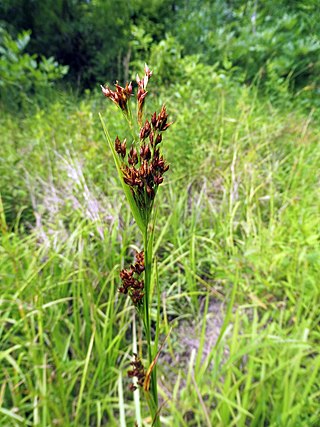
Rhynchospora caduca, commonly called anglestem beaksedge, is a species of flowering plant in the sedge family (Cyperaceae). It is native to North America, where it is found in the southeastern United States. Its typical natural habitat is in low, wet areas, such as in marshes, seeps, tidal swamps, pine savannas, and flatwoods.

Rhynchospora scirpoides, also referred to as Psilocarya scirpoides; common names long-beaked beaksedge and long-beaked bald rush; is a plant in the Rhynchospora genus found in North America.
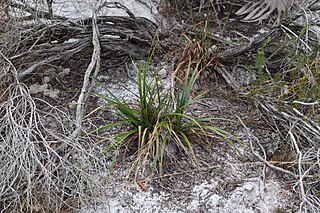
Rhynchospora megalocarpa, commonly called sandyfield beaksedge, is a species of flowering plant in the sedge family (Cyperaceae). It is native to North America, where it is found in the southeastern United States.

Dichanthelium scabriusculum common names tall swamp rosette-panicgrass, tall swamp panicgrass, rough panic-grass and panic grass, is a species of plant found in North America. It is listed as endangered in Connecticut, Maryland, and New York (state). It is listed as threatened in Massachusetts.
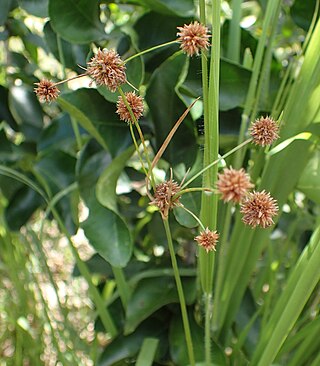
Rhynchospora holoschoenoides, known by the common name of fly beaksedge, is a member of the sedge family, Cyperaceae. It is a perennial herb, found throughout the Caribbean, Central and South America and western and southern Africa.

Rhynchospora careyana, known by the common name of broadfruit horned beaksedge, is a member of the sedge family, Cyperaceae. It is found in marshy areas near the Gulf coast of the southeastern United States, from western Louisiana to southeastern Georgia.















